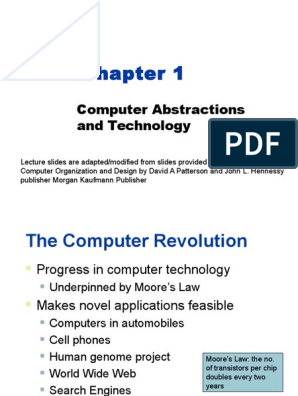0% found this document useful (0 votes)
15 views58 pagesLecture1 - Computer Abstractions and Technology v2
The document discusses the evolution of computer organization, highlighting key milestones such as the Hollerith Tabulating Machine, the Turing Machine, and the Von Neumann model. It explains the impact of Moore's Law on technology scaling and the classification of computers into categories like personal, server, and supercomputers. Additionally, it covers performance metrics, instruction count, and the factors influencing CPU performance.
Uploaded by
matt33768.ee11Copyright
© © All Rights Reserved
We take content rights seriously. If you suspect this is your content, claim it here.
Available Formats
Download as PDF, TXT or read online on Scribd
0% found this document useful (0 votes)
15 views58 pagesLecture1 - Computer Abstractions and Technology v2
The document discusses the evolution of computer organization, highlighting key milestones such as the Hollerith Tabulating Machine, the Turing Machine, and the Von Neumann model. It explains the impact of Moore's Law on technology scaling and the classification of computers into categories like personal, server, and supercomputers. Additionally, it covers performance metrics, instruction count, and the factors influencing CPU performance.
Uploaded by
matt33768.ee11Copyright
© © All Rights Reserved
We take content rights seriously. If you suspect this is your content, claim it here.
Available Formats
Download as PDF, TXT or read online on Scribd
/ 58
























































































